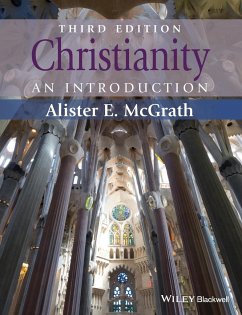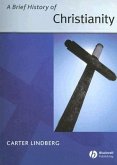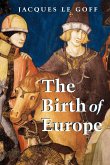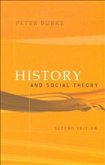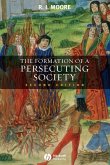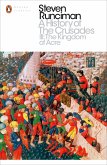- Broschiertes Buch
- Merkliste
- Auf die Merkliste
- Bewerten Bewerten
- Teilen
- Produkt teilen
- Produkterinnerung
- Produkterinnerung
Now available in a fully-revised and updated new edition, this popular textbook by one of the world's leading theologians offers a lively, jargon-free introduction to Christianity.
Andere Kunden interessierten sich auch für
![The Germans and the Final Solution The Germans and the Final Solution]() David Bankier (Hebrew University of Jerusalem)The Germans and the Final Solution47,99 €
David Bankier (Hebrew University of Jerusalem)The Germans and the Final Solution47,99 €![A Brief History of Christianity A Brief History of Christianity]() Carter Lindberg (Boston University)A Brief History of Christianity38,99 €
Carter Lindberg (Boston University)A Brief History of Christianity38,99 €![The Birth of Europe The Birth of Europe]() Jacques Le Goff (Pari Ecole des Hautes Etudes en Sciences SocialesThe Birth of Europe43,99 €
Jacques Le Goff (Pari Ecole des Hautes Etudes en Sciences SocialesThe Birth of Europe43,99 €![History and Social Theory History and Social Theory]() Peter Burke (Cambridge Emmanuel College)History and Social Theory29,99 €
Peter Burke (Cambridge Emmanuel College)History and Social Theory29,99 €![The Formation of a Persecuting Society The Formation of a Persecuting Society]() Robert I. Moore (UK formerly University of Newcastle-upon-Tyne)The Formation of a Persecuting Society41,99 €
Robert I. Moore (UK formerly University of Newcastle-upon-Tyne)The Formation of a Persecuting Society41,99 €![Sources and Debates in English History, 1485 - 1714 Sources and Debates in English History, 1485 - 1714]() Sources and Debates in English History, 1485 - 171466,99 €
Sources and Debates in English History, 1485 - 171466,99 €![A History of the Crusades III A History of the Crusades III]() Steven RuncimanA History of the Crusades III18,99 €
Steven RuncimanA History of the Crusades III18,99 €-
-
-
Now available in a fully-revised and updated new edition, this popular textbook by one of the world's leading theologians offers a lively, jargon-free introduction to Christianity.
Hinweis: Dieser Artikel kann nur an eine deutsche Lieferadresse ausgeliefert werden.
Hinweis: Dieser Artikel kann nur an eine deutsche Lieferadresse ausgeliefert werden.
Produktdetails
- Produktdetails
- Verlag: John Wiley and Sons Ltd
- 3 ed
- Seitenzahl: 320
- Erscheinungstermin: 30. Januar 2015
- Englisch
- Abmessung: 246mm x 189mm x 18mm
- Gewicht: 694g
- ISBN-13: 9781118465653
- ISBN-10: 1118465652
- Artikelnr.: 41750431
- Herstellerkennzeichnung
- Libri GmbH
- Europaallee 1
- 36244 Bad Hersfeld
- gpsr@libri.de
- Verlag: John Wiley and Sons Ltd
- 3 ed
- Seitenzahl: 320
- Erscheinungstermin: 30. Januar 2015
- Englisch
- Abmessung: 246mm x 189mm x 18mm
- Gewicht: 694g
- ISBN-13: 9781118465653
- ISBN-10: 1118465652
- Artikelnr.: 41750431
- Herstellerkennzeichnung
- Libri GmbH
- Europaallee 1
- 36244 Bad Hersfeld
- gpsr@libri.de
Alister E. McGrath is Andreas Idreos Professor of Science and Religion at the University of Oxford. One of the world's leading theologians, he has written numerous critically acclaimed books, including Why God Won't Go Away: Engaging the New Atheism (2011), Darwinism and the Divine: Evolutionary Thought and Natural Theology (Wiley, 2011), and The Intellectual World of C. S. Lewis (Wiley, 2013). He is also the author of some of the most widely used theology textbooks, including the bestselling Christian Theology: An Introduction, now in its fifth edition (Wiley, 2010), Historical Theology: An Introduction (2nd edition; Wiley, 2012), and Theology: The Basics (3rd edition; Wiley, 2011).
Preface xii
List of Illustrations and Maps xiii
Introduction 1
1 Jesus of Nazareth and the Origins of Christianity 3
The Significance of Jesus of Nazareth for Christianity 3
The Sources of Our Knowledge about Jesus of Nazareth 5
Jesus of Nazareth in His Jewish Context 7
The Gospels and Jesus of Nazareth 9
The Birth of Jesus of Nazareth 10
The Early Ministry of Jesus of Nazareth 13
The Teaching of Jesus of Nazareth: The Parables of the Kingdom 15
The Crucifixion of Jesus of Nazareth 17
The Resurrection of Jesus of Nazareth 19
Events and Meanings: The Interpretation of the History of Jesus 21
The New Testament Understandings of the Significance of Jesus 22
Jesus of Nazareth and Women 25
The Reception of Jesus of Nazareth outside Judaism 26
2 The Christian Bible 28
The Old Testament 30
Major Themes of the Old Testament 32
The creation 32
Abraham: Calling and covenant 32
The exodus and the giving of the Law 33
The establishment of the monarchy 36
The priesthood 37
Prophecy 37
Exile and restoration 38
The New Testament 40
The gospels 41
The New Testament letters 44
The fixing of the New Testament canon 45
The Christian Understanding of the Relation of the Old and New Testaments
47
The Translation of the Bible 49
The Bible and Tradition 51
3 Christian Creeds and Beliefs 54
The Emergence of Creeds 55
What Is Faith? 59
Faith and reason 61
Can God's existence be proved? 63
The Christian Understanding of God 65
Christian analogies for God 66
God as Father 67
A personal God 69
God as almighty 71
God as spirit 72
The doctrine of the Trinity 74
God as the creator 78
The Christian Understanding of Humanity 82
Humanity and the "image of God" 83
Humanity, the fall, and sin 84
Jesus of Nazareth 86
Early Christian approaches to the identity of Jesus of Nazareth 87
The Arian controversy and the incarnation 88
The incarnation: The Chalcedonian definition 89
Jesus of Nazareth as mediator between God and humanity 90
Islamic criticisms of the Christian understanding of Jesus of Nazareth 91
The Christian Understanding of Salvation 92
New Testament images of salvation 93
Christ the victor: The defeat of death and sin 94
Christ the harrower of hell: Atonement as restoration 96
Christ the redeemer: Atonement as satisfaction 98
The death of Christ as a perfect sacrifice 99
Christ the lover: Atonement and the enkindling of love 100
Salvation and the "threefold office of Christ" 101
Grace 102
The Pelagian controversy of the fifth century 103
The Reformation debates of the sixteenth century 105
The Church 106
The unity of the church 106
The holiness of the church 107
The catholicity of the church 109
The apostolicity of the church 110
The Sacraments 112
What is a sacrament? 112
The function of sacraments 113
Debates about baptism 115
Debates about the eucharist 116
The Christian Hope 117
The New Testament and Christian hope 117
The nature of the resurrection body 118
Christian burial or cremation? 119
Conclusion 120
4 Christian History: An Overview 121
The Early Church, c. 100-c. 500 122
The apostolic age 122
Early Christianity and the Roman empire 123
Early Christian worship and organization 125
Women and early Christianity 127
The conversion of the Emperor Constantine 129
The cities and the rise of monasticism 131
The fall of the Roman empire 133
The Middle Ages and the Renaissance, c. 500-c. 1500 135
The development of Celtic Christianity 135
The rise of the monastic and cathedral schools 137
The "Great Schism" between East and West (1054) 138
The crusades: Spain and the Middle East 139
Academic theology: The rise of scholasticism 141
Secular and religious power in the Middle Ages 142
Popular religion: The cult of the saints 143
The rise of the Ottoman empire: The fall of Constantinople (1453) 145
The rebirth of western culture: The Renaissance 146
Competing Visions of Reform, c. 1500-c. 1650 148
Christian expansion: Portuguese and Spanish voyages of discovery 149
The Lutheran Reformation 151
The Calvinist Reformation 153
The Radical Reformation (Anabaptism) 154
The Catholic Reformation 155
The Reformation in England 156
The Council of Trent 157
The Society of Jesus 158
The Wars of Religion 158
Puritanism in England and America 159
A Protestant religion of the heart: Pietism 160
American Protestantism and the Great Awakening 162
The Modern Period, c. 1650-1914 163
The rise of indifference to religion in Europe 164
The Enlightenment: The rise of rationalism 164
Christianity in the American Revolution 166
Church and state in America: The "wall of separation" 167
The French Revolution and "dechristianization" 168
Orthodox resurgence: The Greek War of Independence 169
A new expansion of Christianity: The age of mission 170
The shifting fortunes of Catholicism 173
The First Vatican Council: Papal infallibility 175
Theological revisionism: The challenge of modernism 176
The Victorian crisis of faith 177
Pentecostalism: The American origins of a global faith 179
The Twentieth Century, 1914 to the Present 180
The Armenian genocide of 1915 181
The Russian Revolution of 1917 182
America: The fundamentalist controversy 184
The German church crisis of the 1930s 186
The 1960s: The emergence of a post-Christian Europe 188
The Second Vatican Council: Reform and revitalization 189
Christianity and the American Civil Rights Movement 191
Faith renewed: John Paul II and the collapse of the Soviet Union 192
Challenging the church's establishment: Feminism and liberation theology
194
Christianity beyond the West: The globalization of faith 196
Conclusion 198
5 Denominations: Contemporary Forms of Christianity 199
Catholicism 199
Eastern Orthodoxy 203
Protestantism 205
Anglicanism 206
The Baptists 207
Lutheranism 209
Methodism 209
Presbyterianism and other reformed denominations 211
Pentecostalism 212
Evangelicalism 213
The Ecumenical Movement and the World Council of Churches 214
The Erosion of Protestant Denominationalism in the United States 216
Conclusion 218
6 The Life of Faith: Christianity as a Living Reality 220
Gateways to Exploring the Life of Faith 220
Christian Communities: The Life of the Church 222
Christian weddings 222
Christian funerals 223
The Service of Nine Lessons and Carols 225
Christian Worship 226
Prayer 228
Praise 229
The public reading of the Bible 229
Preaching 230
The reciting of the creeds 230
The Sacraments 231
Baptism 232
The eucharist 234
Rhythms and Seasons: The Christian Year 236
Advent 238
Christmas 238
Epiphany 239
Lent 240
Holy Week 241
Easter 243
Ascension 245
Pentecost 245
Trinity 245
The Structuring of Time: The Monastic Day 246
The Structuring of Space: Pilgrimage and the Christian Life 247
Conclusion 250
7 Christianity and the Shaping of Culture 251
Christianity and Culture: General Considerations 252
Christian Symbolism: The Cross 256
Christian Art 259
Icons 262
Church Architecture 263
Stained Glass 268
Christian Music 270
Christianity and Literature 271
Christianity and the Natural Sciences 275
Conclusion 277
Conclusion: Where Next? 278
Further Reading 280
Sources of Quotations 284
Index 291
List of Illustrations and Maps xiii
Introduction 1
1 Jesus of Nazareth and the Origins of Christianity 3
The Significance of Jesus of Nazareth for Christianity 3
The Sources of Our Knowledge about Jesus of Nazareth 5
Jesus of Nazareth in His Jewish Context 7
The Gospels and Jesus of Nazareth 9
The Birth of Jesus of Nazareth 10
The Early Ministry of Jesus of Nazareth 13
The Teaching of Jesus of Nazareth: The Parables of the Kingdom 15
The Crucifixion of Jesus of Nazareth 17
The Resurrection of Jesus of Nazareth 19
Events and Meanings: The Interpretation of the History of Jesus 21
The New Testament Understandings of the Significance of Jesus 22
Jesus of Nazareth and Women 25
The Reception of Jesus of Nazareth outside Judaism 26
2 The Christian Bible 28
The Old Testament 30
Major Themes of the Old Testament 32
The creation 32
Abraham: Calling and covenant 32
The exodus and the giving of the Law 33
The establishment of the monarchy 36
The priesthood 37
Prophecy 37
Exile and restoration 38
The New Testament 40
The gospels 41
The New Testament letters 44
The fixing of the New Testament canon 45
The Christian Understanding of the Relation of the Old and New Testaments
47
The Translation of the Bible 49
The Bible and Tradition 51
3 Christian Creeds and Beliefs 54
The Emergence of Creeds 55
What Is Faith? 59
Faith and reason 61
Can God's existence be proved? 63
The Christian Understanding of God 65
Christian analogies for God 66
God as Father 67
A personal God 69
God as almighty 71
God as spirit 72
The doctrine of the Trinity 74
God as the creator 78
The Christian Understanding of Humanity 82
Humanity and the "image of God" 83
Humanity, the fall, and sin 84
Jesus of Nazareth 86
Early Christian approaches to the identity of Jesus of Nazareth 87
The Arian controversy and the incarnation 88
The incarnation: The Chalcedonian definition 89
Jesus of Nazareth as mediator between God and humanity 90
Islamic criticisms of the Christian understanding of Jesus of Nazareth 91
The Christian Understanding of Salvation 92
New Testament images of salvation 93
Christ the victor: The defeat of death and sin 94
Christ the harrower of hell: Atonement as restoration 96
Christ the redeemer: Atonement as satisfaction 98
The death of Christ as a perfect sacrifice 99
Christ the lover: Atonement and the enkindling of love 100
Salvation and the "threefold office of Christ" 101
Grace 102
The Pelagian controversy of the fifth century 103
The Reformation debates of the sixteenth century 105
The Church 106
The unity of the church 106
The holiness of the church 107
The catholicity of the church 109
The apostolicity of the church 110
The Sacraments 112
What is a sacrament? 112
The function of sacraments 113
Debates about baptism 115
Debates about the eucharist 116
The Christian Hope 117
The New Testament and Christian hope 117
The nature of the resurrection body 118
Christian burial or cremation? 119
Conclusion 120
4 Christian History: An Overview 121
The Early Church, c. 100-c. 500 122
The apostolic age 122
Early Christianity and the Roman empire 123
Early Christian worship and organization 125
Women and early Christianity 127
The conversion of the Emperor Constantine 129
The cities and the rise of monasticism 131
The fall of the Roman empire 133
The Middle Ages and the Renaissance, c. 500-c. 1500 135
The development of Celtic Christianity 135
The rise of the monastic and cathedral schools 137
The "Great Schism" between East and West (1054) 138
The crusades: Spain and the Middle East 139
Academic theology: The rise of scholasticism 141
Secular and religious power in the Middle Ages 142
Popular religion: The cult of the saints 143
The rise of the Ottoman empire: The fall of Constantinople (1453) 145
The rebirth of western culture: The Renaissance 146
Competing Visions of Reform, c. 1500-c. 1650 148
Christian expansion: Portuguese and Spanish voyages of discovery 149
The Lutheran Reformation 151
The Calvinist Reformation 153
The Radical Reformation (Anabaptism) 154
The Catholic Reformation 155
The Reformation in England 156
The Council of Trent 157
The Society of Jesus 158
The Wars of Religion 158
Puritanism in England and America 159
A Protestant religion of the heart: Pietism 160
American Protestantism and the Great Awakening 162
The Modern Period, c. 1650-1914 163
The rise of indifference to religion in Europe 164
The Enlightenment: The rise of rationalism 164
Christianity in the American Revolution 166
Church and state in America: The "wall of separation" 167
The French Revolution and "dechristianization" 168
Orthodox resurgence: The Greek War of Independence 169
A new expansion of Christianity: The age of mission 170
The shifting fortunes of Catholicism 173
The First Vatican Council: Papal infallibility 175
Theological revisionism: The challenge of modernism 176
The Victorian crisis of faith 177
Pentecostalism: The American origins of a global faith 179
The Twentieth Century, 1914 to the Present 180
The Armenian genocide of 1915 181
The Russian Revolution of 1917 182
America: The fundamentalist controversy 184
The German church crisis of the 1930s 186
The 1960s: The emergence of a post-Christian Europe 188
The Second Vatican Council: Reform and revitalization 189
Christianity and the American Civil Rights Movement 191
Faith renewed: John Paul II and the collapse of the Soviet Union 192
Challenging the church's establishment: Feminism and liberation theology
194
Christianity beyond the West: The globalization of faith 196
Conclusion 198
5 Denominations: Contemporary Forms of Christianity 199
Catholicism 199
Eastern Orthodoxy 203
Protestantism 205
Anglicanism 206
The Baptists 207
Lutheranism 209
Methodism 209
Presbyterianism and other reformed denominations 211
Pentecostalism 212
Evangelicalism 213
The Ecumenical Movement and the World Council of Churches 214
The Erosion of Protestant Denominationalism in the United States 216
Conclusion 218
6 The Life of Faith: Christianity as a Living Reality 220
Gateways to Exploring the Life of Faith 220
Christian Communities: The Life of the Church 222
Christian weddings 222
Christian funerals 223
The Service of Nine Lessons and Carols 225
Christian Worship 226
Prayer 228
Praise 229
The public reading of the Bible 229
Preaching 230
The reciting of the creeds 230
The Sacraments 231
Baptism 232
The eucharist 234
Rhythms and Seasons: The Christian Year 236
Advent 238
Christmas 238
Epiphany 239
Lent 240
Holy Week 241
Easter 243
Ascension 245
Pentecost 245
Trinity 245
The Structuring of Time: The Monastic Day 246
The Structuring of Space: Pilgrimage and the Christian Life 247
Conclusion 250
7 Christianity and the Shaping of Culture 251
Christianity and Culture: General Considerations 252
Christian Symbolism: The Cross 256
Christian Art 259
Icons 262
Church Architecture 263
Stained Glass 268
Christian Music 270
Christianity and Literature 271
Christianity and the Natural Sciences 275
Conclusion 277
Conclusion: Where Next? 278
Further Reading 280
Sources of Quotations 284
Index 291
Preface xii
List of Illustrations and Maps xiii
Introduction 1
1 Jesus of Nazareth and the Origins of Christianity 3
The Significance of Jesus of Nazareth for Christianity 3
The Sources of Our Knowledge about Jesus of Nazareth 5
Jesus of Nazareth in His Jewish Context 7
The Gospels and Jesus of Nazareth 9
The Birth of Jesus of Nazareth 10
The Early Ministry of Jesus of Nazareth 13
The Teaching of Jesus of Nazareth: The Parables of the Kingdom 15
The Crucifixion of Jesus of Nazareth 17
The Resurrection of Jesus of Nazareth 19
Events and Meanings: The Interpretation of the History of Jesus 21
The New Testament Understandings of the Significance of Jesus 22
Jesus of Nazareth and Women 25
The Reception of Jesus of Nazareth outside Judaism 26
2 The Christian Bible 28
The Old Testament 30
Major Themes of the Old Testament 32
The creation 32
Abraham: Calling and covenant 32
The exodus and the giving of the Law 33
The establishment of the monarchy 36
The priesthood 37
Prophecy 37
Exile and restoration 38
The New Testament 40
The gospels 41
The New Testament letters 44
The fixing of the New Testament canon 45
The Christian Understanding of the Relation of the Old and New Testaments
47
The Translation of the Bible 49
The Bible and Tradition 51
3 Christian Creeds and Beliefs 54
The Emergence of Creeds 55
What Is Faith? 59
Faith and reason 61
Can God's existence be proved? 63
The Christian Understanding of God 65
Christian analogies for God 66
God as Father 67
A personal God 69
God as almighty 71
God as spirit 72
The doctrine of the Trinity 74
God as the creator 78
The Christian Understanding of Humanity 82
Humanity and the "image of God" 83
Humanity, the fall, and sin 84
Jesus of Nazareth 86
Early Christian approaches to the identity of Jesus of Nazareth 87
The Arian controversy and the incarnation 88
The incarnation: The Chalcedonian definition 89
Jesus of Nazareth as mediator between God and humanity 90
Islamic criticisms of the Christian understanding of Jesus of Nazareth 91
The Christian Understanding of Salvation 92
New Testament images of salvation 93
Christ the victor: The defeat of death and sin 94
Christ the harrower of hell: Atonement as restoration 96
Christ the redeemer: Atonement as satisfaction 98
The death of Christ as a perfect sacrifice 99
Christ the lover: Atonement and the enkindling of love 100
Salvation and the "threefold office of Christ" 101
Grace 102
The Pelagian controversy of the fifth century 103
The Reformation debates of the sixteenth century 105
The Church 106
The unity of the church 106
The holiness of the church 107
The catholicity of the church 109
The apostolicity of the church 110
The Sacraments 112
What is a sacrament? 112
The function of sacraments 113
Debates about baptism 115
Debates about the eucharist 116
The Christian Hope 117
The New Testament and Christian hope 117
The nature of the resurrection body 118
Christian burial or cremation? 119
Conclusion 120
4 Christian History: An Overview 121
The Early Church, c. 100-c. 500 122
The apostolic age 122
Early Christianity and the Roman empire 123
Early Christian worship and organization 125
Women and early Christianity 127
The conversion of the Emperor Constantine 129
The cities and the rise of monasticism 131
The fall of the Roman empire 133
The Middle Ages and the Renaissance, c. 500-c. 1500 135
The development of Celtic Christianity 135
The rise of the monastic and cathedral schools 137
The "Great Schism" between East and West (1054) 138
The crusades: Spain and the Middle East 139
Academic theology: The rise of scholasticism 141
Secular and religious power in the Middle Ages 142
Popular religion: The cult of the saints 143
The rise of the Ottoman empire: The fall of Constantinople (1453) 145
The rebirth of western culture: The Renaissance 146
Competing Visions of Reform, c. 1500-c. 1650 148
Christian expansion: Portuguese and Spanish voyages of discovery 149
The Lutheran Reformation 151
The Calvinist Reformation 153
The Radical Reformation (Anabaptism) 154
The Catholic Reformation 155
The Reformation in England 156
The Council of Trent 157
The Society of Jesus 158
The Wars of Religion 158
Puritanism in England and America 159
A Protestant religion of the heart: Pietism 160
American Protestantism and the Great Awakening 162
The Modern Period, c. 1650-1914 163
The rise of indifference to religion in Europe 164
The Enlightenment: The rise of rationalism 164
Christianity in the American Revolution 166
Church and state in America: The "wall of separation" 167
The French Revolution and "dechristianization" 168
Orthodox resurgence: The Greek War of Independence 169
A new expansion of Christianity: The age of mission 170
The shifting fortunes of Catholicism 173
The First Vatican Council: Papal infallibility 175
Theological revisionism: The challenge of modernism 176
The Victorian crisis of faith 177
Pentecostalism: The American origins of a global faith 179
The Twentieth Century, 1914 to the Present 180
The Armenian genocide of 1915 181
The Russian Revolution of 1917 182
America: The fundamentalist controversy 184
The German church crisis of the 1930s 186
The 1960s: The emergence of a post-Christian Europe 188
The Second Vatican Council: Reform and revitalization 189
Christianity and the American Civil Rights Movement 191
Faith renewed: John Paul II and the collapse of the Soviet Union 192
Challenging the church's establishment: Feminism and liberation theology
194
Christianity beyond the West: The globalization of faith 196
Conclusion 198
5 Denominations: Contemporary Forms of Christianity 199
Catholicism 199
Eastern Orthodoxy 203
Protestantism 205
Anglicanism 206
The Baptists 207
Lutheranism 209
Methodism 209
Presbyterianism and other reformed denominations 211
Pentecostalism 212
Evangelicalism 213
The Ecumenical Movement and the World Council of Churches 214
The Erosion of Protestant Denominationalism in the United States 216
Conclusion 218
6 The Life of Faith: Christianity as a Living Reality 220
Gateways to Exploring the Life of Faith 220
Christian Communities: The Life of the Church 222
Christian weddings 222
Christian funerals 223
The Service of Nine Lessons and Carols 225
Christian Worship 226
Prayer 228
Praise 229
The public reading of the Bible 229
Preaching 230
The reciting of the creeds 230
The Sacraments 231
Baptism 232
The eucharist 234
Rhythms and Seasons: The Christian Year 236
Advent 238
Christmas 238
Epiphany 239
Lent 240
Holy Week 241
Easter 243
Ascension 245
Pentecost 245
Trinity 245
The Structuring of Time: The Monastic Day 246
The Structuring of Space: Pilgrimage and the Christian Life 247
Conclusion 250
7 Christianity and the Shaping of Culture 251
Christianity and Culture: General Considerations 252
Christian Symbolism: The Cross 256
Christian Art 259
Icons 262
Church Architecture 263
Stained Glass 268
Christian Music 270
Christianity and Literature 271
Christianity and the Natural Sciences 275
Conclusion 277
Conclusion: Where Next? 278
Further Reading 280
Sources of Quotations 284
Index 291
List of Illustrations and Maps xiii
Introduction 1
1 Jesus of Nazareth and the Origins of Christianity 3
The Significance of Jesus of Nazareth for Christianity 3
The Sources of Our Knowledge about Jesus of Nazareth 5
Jesus of Nazareth in His Jewish Context 7
The Gospels and Jesus of Nazareth 9
The Birth of Jesus of Nazareth 10
The Early Ministry of Jesus of Nazareth 13
The Teaching of Jesus of Nazareth: The Parables of the Kingdom 15
The Crucifixion of Jesus of Nazareth 17
The Resurrection of Jesus of Nazareth 19
Events and Meanings: The Interpretation of the History of Jesus 21
The New Testament Understandings of the Significance of Jesus 22
Jesus of Nazareth and Women 25
The Reception of Jesus of Nazareth outside Judaism 26
2 The Christian Bible 28
The Old Testament 30
Major Themes of the Old Testament 32
The creation 32
Abraham: Calling and covenant 32
The exodus and the giving of the Law 33
The establishment of the monarchy 36
The priesthood 37
Prophecy 37
Exile and restoration 38
The New Testament 40
The gospels 41
The New Testament letters 44
The fixing of the New Testament canon 45
The Christian Understanding of the Relation of the Old and New Testaments
47
The Translation of the Bible 49
The Bible and Tradition 51
3 Christian Creeds and Beliefs 54
The Emergence of Creeds 55
What Is Faith? 59
Faith and reason 61
Can God's existence be proved? 63
The Christian Understanding of God 65
Christian analogies for God 66
God as Father 67
A personal God 69
God as almighty 71
God as spirit 72
The doctrine of the Trinity 74
God as the creator 78
The Christian Understanding of Humanity 82
Humanity and the "image of God" 83
Humanity, the fall, and sin 84
Jesus of Nazareth 86
Early Christian approaches to the identity of Jesus of Nazareth 87
The Arian controversy and the incarnation 88
The incarnation: The Chalcedonian definition 89
Jesus of Nazareth as mediator between God and humanity 90
Islamic criticisms of the Christian understanding of Jesus of Nazareth 91
The Christian Understanding of Salvation 92
New Testament images of salvation 93
Christ the victor: The defeat of death and sin 94
Christ the harrower of hell: Atonement as restoration 96
Christ the redeemer: Atonement as satisfaction 98
The death of Christ as a perfect sacrifice 99
Christ the lover: Atonement and the enkindling of love 100
Salvation and the "threefold office of Christ" 101
Grace 102
The Pelagian controversy of the fifth century 103
The Reformation debates of the sixteenth century 105
The Church 106
The unity of the church 106
The holiness of the church 107
The catholicity of the church 109
The apostolicity of the church 110
The Sacraments 112
What is a sacrament? 112
The function of sacraments 113
Debates about baptism 115
Debates about the eucharist 116
The Christian Hope 117
The New Testament and Christian hope 117
The nature of the resurrection body 118
Christian burial or cremation? 119
Conclusion 120
4 Christian History: An Overview 121
The Early Church, c. 100-c. 500 122
The apostolic age 122
Early Christianity and the Roman empire 123
Early Christian worship and organization 125
Women and early Christianity 127
The conversion of the Emperor Constantine 129
The cities and the rise of monasticism 131
The fall of the Roman empire 133
The Middle Ages and the Renaissance, c. 500-c. 1500 135
The development of Celtic Christianity 135
The rise of the monastic and cathedral schools 137
The "Great Schism" between East and West (1054) 138
The crusades: Spain and the Middle East 139
Academic theology: The rise of scholasticism 141
Secular and religious power in the Middle Ages 142
Popular religion: The cult of the saints 143
The rise of the Ottoman empire: The fall of Constantinople (1453) 145
The rebirth of western culture: The Renaissance 146
Competing Visions of Reform, c. 1500-c. 1650 148
Christian expansion: Portuguese and Spanish voyages of discovery 149
The Lutheran Reformation 151
The Calvinist Reformation 153
The Radical Reformation (Anabaptism) 154
The Catholic Reformation 155
The Reformation in England 156
The Council of Trent 157
The Society of Jesus 158
The Wars of Religion 158
Puritanism in England and America 159
A Protestant religion of the heart: Pietism 160
American Protestantism and the Great Awakening 162
The Modern Period, c. 1650-1914 163
The rise of indifference to religion in Europe 164
The Enlightenment: The rise of rationalism 164
Christianity in the American Revolution 166
Church and state in America: The "wall of separation" 167
The French Revolution and "dechristianization" 168
Orthodox resurgence: The Greek War of Independence 169
A new expansion of Christianity: The age of mission 170
The shifting fortunes of Catholicism 173
The First Vatican Council: Papal infallibility 175
Theological revisionism: The challenge of modernism 176
The Victorian crisis of faith 177
Pentecostalism: The American origins of a global faith 179
The Twentieth Century, 1914 to the Present 180
The Armenian genocide of 1915 181
The Russian Revolution of 1917 182
America: The fundamentalist controversy 184
The German church crisis of the 1930s 186
The 1960s: The emergence of a post-Christian Europe 188
The Second Vatican Council: Reform and revitalization 189
Christianity and the American Civil Rights Movement 191
Faith renewed: John Paul II and the collapse of the Soviet Union 192
Challenging the church's establishment: Feminism and liberation theology
194
Christianity beyond the West: The globalization of faith 196
Conclusion 198
5 Denominations: Contemporary Forms of Christianity 199
Catholicism 199
Eastern Orthodoxy 203
Protestantism 205
Anglicanism 206
The Baptists 207
Lutheranism 209
Methodism 209
Presbyterianism and other reformed denominations 211
Pentecostalism 212
Evangelicalism 213
The Ecumenical Movement and the World Council of Churches 214
The Erosion of Protestant Denominationalism in the United States 216
Conclusion 218
6 The Life of Faith: Christianity as a Living Reality 220
Gateways to Exploring the Life of Faith 220
Christian Communities: The Life of the Church 222
Christian weddings 222
Christian funerals 223
The Service of Nine Lessons and Carols 225
Christian Worship 226
Prayer 228
Praise 229
The public reading of the Bible 229
Preaching 230
The reciting of the creeds 230
The Sacraments 231
Baptism 232
The eucharist 234
Rhythms and Seasons: The Christian Year 236
Advent 238
Christmas 238
Epiphany 239
Lent 240
Holy Week 241
Easter 243
Ascension 245
Pentecost 245
Trinity 245
The Structuring of Time: The Monastic Day 246
The Structuring of Space: Pilgrimage and the Christian Life 247
Conclusion 250
7 Christianity and the Shaping of Culture 251
Christianity and Culture: General Considerations 252
Christian Symbolism: The Cross 256
Christian Art 259
Icons 262
Church Architecture 263
Stained Glass 268
Christian Music 270
Christianity and Literature 271
Christianity and the Natural Sciences 275
Conclusion 277
Conclusion: Where Next? 278
Further Reading 280
Sources of Quotations 284
Index 291
Praise for the Previous Edition
Meticulous and memorable, Christianity: An Introduction(second edition) takes us on a breathtaking journey, andreaders of all kinds will enjoy the ride.Darren J. N. Middleton,Texas Christian University
The finest text of its kind available. It isencyclopaedic in scope, reliable and quite accessible to thenon-specialist. In this second edition, an already solid resourceis made even more valuable." David L. Johns, EarlhamSchool of Religion
Meticulous and memorable, Christianity: An Introduction(second edition) takes us on a breathtaking journey, andreaders of all kinds will enjoy the ride.Darren J. N. Middleton,Texas Christian University
The finest text of its kind available. It isencyclopaedic in scope, reliable and quite accessible to thenon-specialist. In this second edition, an already solid resourceis made even more valuable." David L. Johns, EarlhamSchool of Religion

